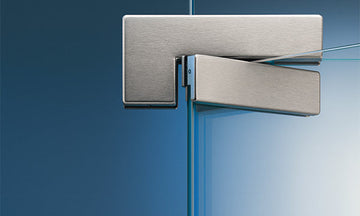
Patch fittings are compact, surface-mounted hardware “patches” that clamp onto the edges and corners of toughened glass to create frameless doors and partitions. Instead of relying on bulky frames, patch fittings deliver the clamping force, pivot points, locking, and alignment that a glass door needs—while keeping sightlines clean and contemporary. A typical single swing door uses a bottom patch to carry the weight on a floor spring or pivot, a top patch for the upper pivot, and optional lock and strike patches for security. For shopfronts and office entrances, patch fittings also join fixed side panels to door leaves using patch connectors at 90°, 135°, or 180°.
On suppliers like Quality Glass Fittings (QGF) you’ll find patch components designed for the most common glass thicknesses (usually 8–12 mm, sometimes up to 15 mm), with gaskets sized to match the pane and protect the glass. The result is a robust, modular system that looks minimal but performs like a full frame.
Types of Patch Fittings

Below are the core components you’ll encounter when planning a frameless glass entrance. You’ll typically combine several of these into one system.
1) Bottom Patch (Door Shoe)
- Purpose: Carries almost all the door weight and transfers it to the floor spring or bottom pivot.
- Features: Clamping plates and gaskets, adjustable pivot pin height, sometimes a “strap” style that wraps the lower corner of the glass for extra grip.
- When to use: Every pivoting or floor-spring door requires a bottom patch. Choose power and pin type to match the closer/pivot.
2) Top Patch
- Purpose: Provides the upper pivot point and keeps the door aligned with the transom or frame head.
- Features: Adjustable top pivot insert, template-matched fixings to align with common top pivots.
- When to use: With any floor-spring door; pairs with a transom pivot or patch.
3) Over panel / Transom Patch
- Purpose: Receives the top pivot when you have a fixed glass over panel instead of a fixed frame.
- Variations:
- Transom patch with pivot (fixes to an over panel and accepts the door’s top pivot)
- Over panel connector (joins fixed panels together at head height)
4) Lock Patch (Corner or Centre)
- Corner lock patch: Mounts on the vertical edge of the door near the handle side; engages with a strike patch on the adjacent fixed panel or wall receiver.
- Centre lock patch: Positioned in the middle of the lock stile for symmetrical aesthetics; useful on double doors or wide leaves.
- Options: Euro-profile cylinder, thumb-turn, indicator (occupied/vacant), and electric strike compatibility in some systems.
5) Strike Patch / Keeper
- Purpose: Receives the latch or bolt from a lock patch.
- Mounting: On a fixed glass panel (using a patch) or to the wall/floor with a dedicated keeper.
6) Patch Connectors
- Angles: 90°, 135°, 180° connectors join fixed panels together or create returns.
- Applications: Shopfront corners, glass corridors, cubicles, or lobby screens.
- Benefit: Perfectly aligned joints without drilling long rails; clamps are concealed behind neat cover plates.
7) Fin or End Patches
- Purpose: Terminate a run of glass at a wall or column; sometimes include adjustment slots for fine alignment.
8) Pivot Patches (Glass-to-Floor / Glass-to-Glass)
- Purpose: Provide a pivot for doors that don’t use a floor spring (e.g., light doors or internal screens) or pivot against a glass fin instead of a wall.
- Note: Check the door size/weight against the pivot’s rating; floor springs remain the go-to for heavy, high-traffic doors.
9) Accessories to Complete the Set
- Floor springs (hold-open or non-hold-open, power sizes to suit door weight/width)
- Transom closers (when you can’t recess a floor spring)
- Handles and ladder pulls (back-to-back through-bolted)
- Door stops and thresholds (control sweep and protect finishes)
- Seals and drop seals (for weather or smoke control)
Materials and Finishes for Patch Fittings

Patch fittings work hard in public spaces. The material and finish you choose will influence both performance and appearance.
Core materials
- 304 Stainless Steel: The everyday choice for interiors and most exteriors. Strong, corrosion-resistant, and economical.
- 316 Stainless Steel: Enhanced corrosion resistance—ideal for coastal, pool, or harsh urban environments.
- Brass Body with Plated Finish: Excellent machinability and weighty feel; often chrome-plated or PVD-coated.
- Zinc Alloy Die-cast: Cost-effective for low-impact areas; quality varies—look for solid clamping hardware and good plating.
Finishes
- Polished (PSS/CP): Mirror sheen that pairs well with polished pulls—great for luxury retail fronts.
- Satin/Brushed (SSS/SNP): Hides fingerprints and minor scratches; the professional default for commercial interiors.
- Matte Black: Powder-coated or anodised look; strong in contemporary and hospitality settings.
- Brushed/Polished Gold or Bronze: PVD finishes deliver the warm tone designers love with far greater durability than paint.
- Custom RAL colours: Some suppliers offer project-matched coatings for brand or design continuity.
What matters most: robust clamping plates, correct gasket sets for your glass thickness, and stainless fasteners. A quality patch won’t creak, shed plating, or work loose with heavy use.
Benefits of Using Patch Fittings in Glass Doors

- Minimalist aesthetics
Patch systems create the “all-glass” look architects and interior designers specify for reception areas, boutiques, and office suites. The hardware reduces to crisp rectangles and circles that sit quietly on the glass.
- Modularity and serviceability
Patches are field-replaceable. If a lock wears out or a finish needs upgrading, you can swap the single component without demolishing the whole entrance.
- Fast, repeatable installation
With standard cut-out templates and gasket kits, fabricators can process panels quickly. On-site, installers align patches with adjustable pivots and valves in the floor spring—shortening commissioning time.
- Structural performance
A bottom patch distributes door loads over a large glass area, while the floor spring or pivot bears the weight. Correctly specified, a patch set will handle high traffic for years.
- Design flexibility
Connectors at 90°, 135°, and 180° let you build corners, returns, and long runs of fixed glass without bulky mullions. Lock/strike patches add security exactly where you need it.
- Accessibility and safety
Floor springs provide controlled closing speeds, backcheck, and optional hold-open. Pair with ladder pulls or offset pulls to meet accessibility reach and grip guidelines.
How to Specify the Right Patch System (step-by-step)
Use this checklist to move from concept to a complete bill of materials:
- Opening size and door count
- Clear opening width and height
- Single or double action (swing both ways)
- One leaf or a pair of leaves?
- Glass thickness and type
- Most patch systems: 10–12 mm toughened glass.
- Large or high-traffic doors may benefit from 12 mm.
- If using laminated toughened, confirm compatible gaskets and clamping capacity with the supplier.
- Door weight and closer power
- Match door size/weight to floor spring power size (e.g., EN 2/3/4).
- Choose hold-open (common for stores) or non-hold-open (fire or security routes).
- Traffic and environment
- For coastal or poolside installs, step up to 316 stainless or high-grade PVD finishes.
- Heavy retail traffic may require reinforced bottom patches and frequent service checks.
- Locks and security
- Privacy or out-of-hours security? Choose corner or centre lock patches.
- Decide on thumb-turn vs. key both sides, and ensure the keeper/strike matches adjacent glass or wall.
- Fixed panels and connectors
- Sketch every glass joint; use 90°/135°/180° connectors and fin/end patches where panels meet walls or columns.
- Handles and seals
- Back-to-back ladder pulls are the commercial standard.
- Weather or acoustic control may require bottom thresholds and brush or rubber seals.
- Templates and drilling
- Confirm the cut-out template for your patch series. Many follow established patterns so any reputable glass processor can fabricate accurately.
Also read: Glass to Glass Hinges: Which Type Is Best for Showers?
Maintenance and Troubleshooting Tips
Frameless entrances are robust, but a little care keeps them flawless.
Routine maintenance
- Quarterly cleaning: Wipe plates with a soft cloth and neutral cleaner. Avoid abrasives that damage satin brushes or PVD coatings.
- Fastener check: Inspect patch cover screws and through-bolts on handles. Tighten to manufacturer torque; never overtighten on glass.
- Gasket health: Replace hardened or damaged gaskets. The right elastomer prevents glass slippage and creaks.
- Closer service: For floor springs, check for oil residue (a sign of seal failure), door closing speeds (latch and sweep), and hold-open strength. Adjust valves as needed.
Common issues & fixes
- Door drags or scuffs the floor
- Likely causes: settling slab, incorrect box level, or worn bottom pivot pin.
- Fix: Shim the cover plate, adjust pivot height (some patches offer +/- adjustment), or replace the pivot insert.
- Door won’t self-close or slams
- Causes: incorrect spring power, air in the closer, or valve mis-adjustment.
- Fix: Adjust sweep and latch speeds; if ineffective, service or replace the spring to the proper EN size.
- Latch misalignment
- Causes: movement in fixed panel, loose strike patch, or thermal expansion.
- Fix: Realign the strike plate, check connector patches are tight, and re-square the door.
- Creaking or popping sounds
- Causes: dry gaskets or minor glass movement inside the patch.
- Fix: Verify clamp torque and gasket condition; replace if glazed or crushed.
- Corrosion spots
- Causes: aggressive cleaners or coastal exposure.
- Fix: Switch to neutral pH cleaning, polish out minor tea-staining, and specify 316 SS or PVD finishes for replacements.
Safety note: Patch systems rely on toughened safety glass cut to exact templates. Any re-drilling or grinding on site is unsafe—replace the pane if it’s wrong.
Troubleshooting selection mistakes (so you can avoid them)

- Mismatched glass thickness and gasket set → the glass can slip inside the patch. Always order the correct gasket pack (e.g., 10 mm vs 12 mm).
- Undersized floor spring → door won’t control properly in wind or high traffic. Choose the EN power recommended for your door width/weight.
- Incompatible finishes → matte black patches with polished handles look unplanned. Keep hardware within one finish family.
- Skipping a door stop → the hold-open or backcheck isn’t a stop; fit a physical stop to protect walls and glass edges.
- Forgetting clearances → allow for sweep of ladder pulls and wall returns; ensure thresholds won’t clash with bottom patch cover plates.
Where to Buy Quality Patch Fittings?
For UK projects, Quality Glass Fittings is a convenient one-stop source for frameless door hardware. You’ll typically find:
- Complete patch ranges: bottom and top patches, over panel/transom patches, 90°/135°/180° connectors, lock and strike patches, end/fin patches.
- Matching closers and pivots: floor springs (hold-open or non-hold-open), top pivots, and transom solutions.
- Coordinated hardware: ladder pulls, offset pulls, door knobs, thresholds, brush seals, and door stops to build a coherent specification.
- Finish options: polished and satin stainless, matte black, and warm metallic PVD tones to tie in with your wider design scheme.
- Glass-friendly details: correctly sized gaskets for common glass thicknesses, stainless fasteners, and clear technical drawings/templates.
When you reach out, have this information ready to speed up quoting and avoid mistakes:
- Opening dimensions and door count
- Desired glass thickness and type
- Door leaf width/height and estimated weight
- Traffic level and environment (interior, exterior, coastal)
- Hold-open requirement and closing direction(s)
- Security/lock preference (key/turn, centre or corner)
- Finish choice and any matching accessories (handles, seals)
Pro tip: Ask for a system schedule or parts list that maps each glass panel to its patch components, pivots, and fixings. This becomes your on-site checklist and reduces the chance of missing a connector or strike.
Final Thoughts
Patch fittings are the backbone of frameless glass doors. Get the pairing right—bottom patch + floor spring + top/transom patch—and you have a door that swings smoothly, closes reliably, and looks effortlessly elegant. Add lock/strike patches for security, connectors for fixed panels, and a finish that suits your concept, and you’ve got a professional-grade entrance that will impress for years.
By following the specification checklist, choosing materials appropriate to the environment, and committing to light routine maintenance, you’ll maximise both the longevity and appearance of your installation. When you’re ready to source, a specialist supplier like Quality Glass Fittings can provide the compatible, modular hardware set—and practical guidance—to bring your frameless glass design to life.

